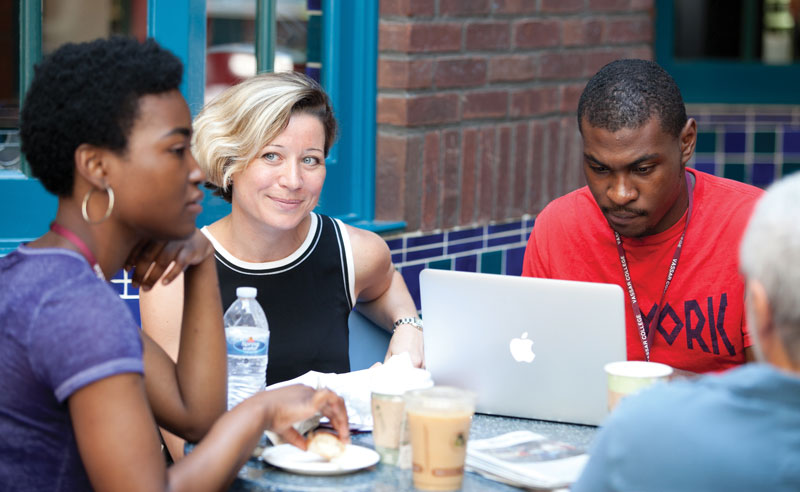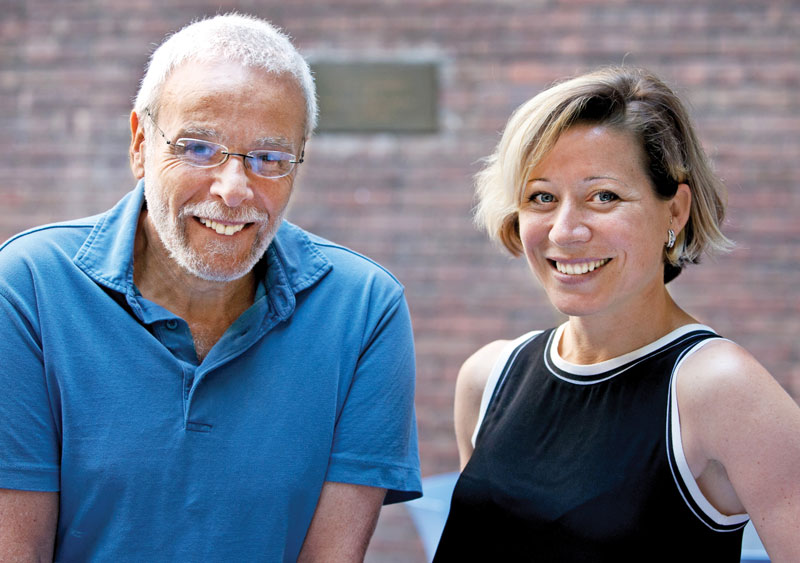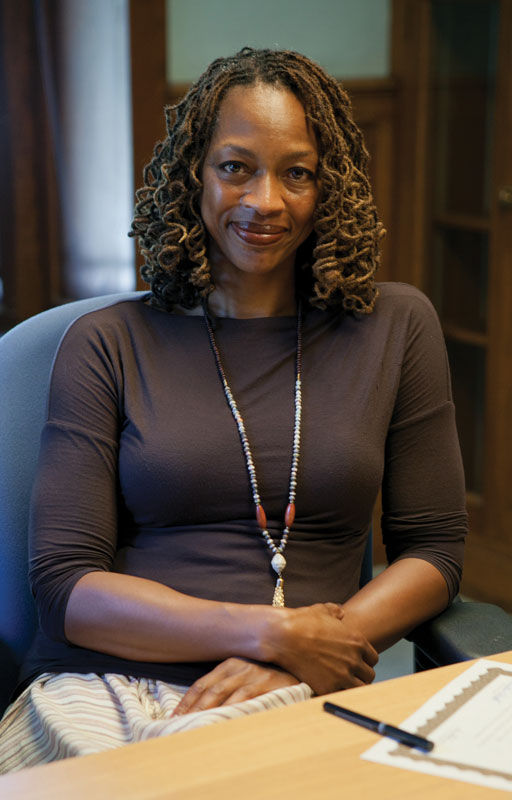Exploring Transfer: Encouraging Four-Year Degrees for 30 Years

Near the conclusion of his five weeks on campus for the Exploring Transfer (ET) program this summer, Borough of Manhattan Community College graduate Roydel Morris, (above right), made it very plain: “I would never have dreamed of something like this, this kind of academic experience. ET was the only way I would know. And it’s been life changing.”
This year marked the 30th anniversary of ET, a first-of-its-kind academic immersion cofounded by Vassar and LaGuardia Community College that more than a thousand community college students have now completed. Whether 20-something or 50-something, they have journeyed to Vassar eager with curiosity about residential liberal arts education, and departed with a much different sense of possibilities for their learning and their lives.
ET was the first broad-based initiative to focus accomplished community college students on eventual transfer to a four-year institution, and it has proven remarkably durable and effective. The centerpiece experience is completing two full-credit Vassar courses compressed into five weeks. Students choose from three course offerings, codesigned and cotaught by Vassar and community college professors, which this summer included “The Economics and Ethics of Life and Death”; “Legal Justice, Social Justice: The Politics of Imprisonment”; and “Writing Race in the U.S.: An Exploration of African-American Literature.”
Like their predecessors, Morris and the 26 other ET students—from community colleges as near as Poughkeepsie and as far away as Los Angeles, Boston, and the Diné Native American reservation in Arizona—gained not only intellectual inspiration from the faculty but immeasurable mutual support from their fellow students.
“We were like a family almost since day one. Everyone was kind of shocked by how fast we all became connected, even the ET counselors who have been through the program,” reflected Morris.
They would rely on that bond.

While students selected for ET have become proficient at juggling school, work, and commuting—and quite often family responsibilities—ET presents them with much different challenges. From day one they must adjust to a reading and writing load that would be “almost impossible” to succeed at in community college, says Morris, because “you’re handling so many other things and wouldn’t have the time to devote to your studies.”
By contrast, “In ET you are given the opportunity of dropping everything but academics. It really felt like a privilege,” explained former Exploring Transfer student Yolanda Martin ’05. “ET made me look at coursework in a completely different light,” she recalled. “We only used original sources and peer-reviewed journal articles. This is very different from community college where we were just exposed to textbooks.”
By providing this combination of academic focus and depth, ET aims to leave its students with the confidence to transfer and complete a bachelor’s degree. Many of these students are already pioneers as the first in their families to attend any college. It’s a testament to ET’s model that, of the more than 1,000 students who have participated, more than 80 percent have gone on to attend a four-year college or university, graduating from the likes of Columbia, Cornell, Swarthmore, Vassar, and Yale, and numerous other public and private schools.
Moreover, the faculty and staff urge students to think boldly about their futures. ET boasts numerous graduates with advanced degrees and careers. After completing his bachelor’s in cognitive science at Vassar and a PhD from MIT in philosophy and cognitive psychology, Gavin Huntley-Fenner ’90 now heads a consultancy that provides scientific advisory services regarding the safe and effective use of consumer products. Darys Estrella ’92 studied economics at Vassar, got her MBA at the University of Michigan, went on to head the Dominican Republic stock exchange (the first woman to hold such a position in Latin America), and is now a Vassar trustee.
After Martin completed her associate’s degree, she immediately transferred to Vassar and graduated two years later with honors in both sociology and Chinese (she’d had no prior experience with the language). She wasted no time jumping right into grad school, and with her sociology PhD she secured a position as assistant professor at Borough of Manhattan Community College. Martin has also made an unexpected loop back to Exploring Transfer; this summer was her second on the ET faculty. In both years, she cotaught with her former ET professor Sidney Plotkin from the Vassar political science department.
How did Vassar and LaGuardia—two schools functioning in very different ways within U.S. higher education—become to create a program as trailblazing as Exploring Transfer?
It began in 1983 with a phone call to Vassar president Virginia Smith from Janet Lieberman, then assistant to LaGuardia’s president. Lieberman explained that her school had just been awarded a Ford Foundation grant to investigate factors inhibiting transfer from community college to a four-year school, and to develop a plan for greater success. LaGuardia believed a college of Vassar’s caliber would be a valuable partner in their project, particularly in examining how the transfer process could be improved at the “receiving” school. LaGuardia also had good history with President Smith; before leading Vassar she was the head of the federal Fund for the Improvement of Postsecondary Education (FIPSE) when Lieberman secured a FIPSE grant to help high school dropouts earn their diploma through LaGuardia.

Smith was agreeable to the overture and quickly asked then Dean of Studies (and longtime English professor) Colton Johnson to team up with Lieberman as the leaders of their institutions’ exploratory efforts. Johnson had already noted the success of Vassar’s small number of community college transfers, and to increase that enrollment had even pursued a closer relationship for Vassar with the local Dutchess Community College.
The core plan that faculty and administrators from the two schools developed over the next two years—and initially launched with 27 students in the summer of 1985 as the “Vassar Summer Program for Community College Students”—is largely what we know today as Exploring Transfer. By 1989, Lieberman and Johnson’s leadership earned them the Charles A. Dana Award for Pioneering Achievement in Higher Education. (In 1998, ET even gained Vassar recognition as the Time/Princeton Review “College of the Year.”)
Yet so many faculty members and college administrators have shepherded ET through its growth and success. Professors—mostly from Vassar and LaGuardia—have stepped in as academic director over the 30 summers. Longtime Vassar and ET writing instructor Tom McGlinchey was administrative coordinator for nearly 20 years. Professors such as Sidney Plotkin (political science), Diane Harriford (sociology), Harvey Flad (geography), and Andrew Bush (Hispanic studies) have taught many years for ET alongside a range of community college colleagues.
Like Martin, fellow ET graduate Bernetta Parson was back in an official capacity at the program this past summer, serving as the interim director. Twenty-two years after completing Exploring Transfer, Parson is now working on a PhD at Syracuse University studying community colleges, the transfer process, and partnerships between community colleges and bachelor degree-granting colleges. But it’s the path that brought Parson to ET that says the most about the program’s wide-reaching effectiveness.
Parson was a single parent who enrolled at LaGuardia after quitting a dead-end job. She earned excellent grades and a professor recommended that she apply to ET. She eventually transferred to Mount Holyoke College where she completed a BA in English.
“The thing that I remember most about ET was being immersed in my studies,” Parson said. “At community college I enjoyed my classes and did well, but in ET I could talk to my classmates and professors about ideas outside of the classroom, at meals, in the dorm, under a tree, at midnight if I wanted. ET was an incredible space—intellectual, physical, temporal, safe—that allowed me to explore all sides of myself, which, in turn, strengthened my academic work.”
